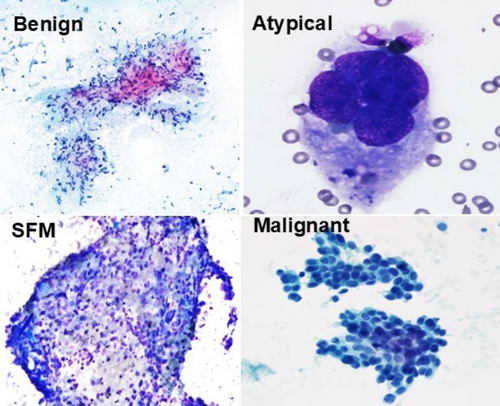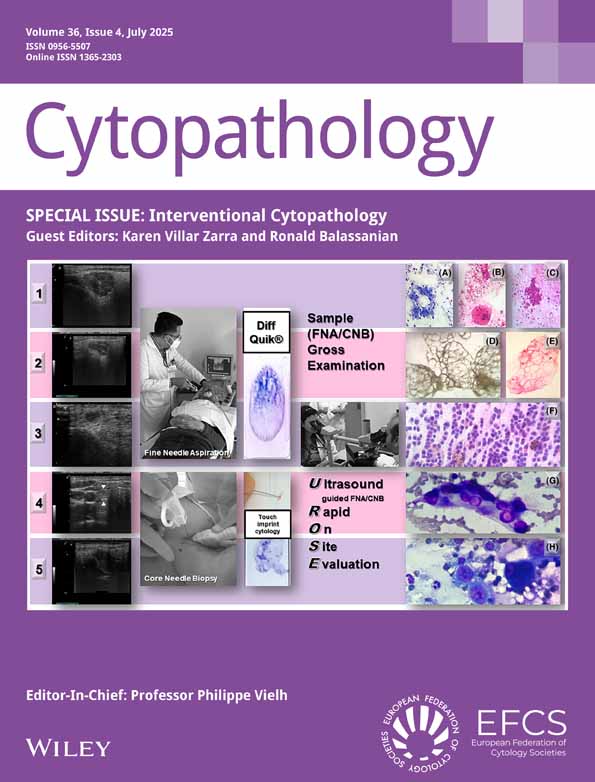An Institutional Experience in Lung Endobronchial Ultrasound-Guided Fine Needle Aspiration: Comparing Risk of Malignancy With WHO Reporting System for Lung Cytopathology
ABSTRACT
Introduction
Our institution utilises diagnostic frameworks similar to WHO Reporting System for Lung Cytopathology (WHORSLC) for assessment of lung fine needle aspiration (FNA) specimens. This study reports risk of malignancy (ROM) across diagnostic categories for comparison with the WHORSLC published data.
Methods
A SNOMED search of the electronic pathology database in our institution (01/2022–12/2023) was conducted to retrieve endobronchial ultrasound (EBUS)-guided lung FNA specimens with a concurrent or subsequent surgical biopsy. Cytologic interpretation of these FNA specimens was performed using diagnostic frameworks similar to WHORSLC. Diagnostic distribution and ROM across the diagnostic categories were evaluated.
Results
Among the 280 identified specimens, 125 (45%) were categorised as malignant, followed by 62 (22%) non-diagnostic, 45 (16%) benign, 33 (12%) atypical, and 15 (5%) suspicious for malignancy (SFM). The corresponding biopsies revealed malignancy in all FNAs categorised as malignant or SFM, as well as 57%, 35%, and 20% of atypical, non-diagnostic, and 20% benign cases, respectively. Among the histology-proven malignancies across the diagnostic categories, the majority were primary lung carcinomas, which most commonly were adenocarcinoma. Non-pulmonary malignancies were mostly seen in atypical (36%) followed by non-diagnostic (27%), SFM (13%), and malignant (10%) categories.
Conclusion
EBUS-guided lung FNA specimens in our cohort categorised as malignant or SFM showed a higher ROM and cyto-histologic concordance (100%) than those reported by the WHORSLC. While our study resulted in a similar ROM for benign, atypical, and malignant categories, the ROM was lower for the non-diagnostic category. These findings contribute to the limited data available and may help further refine the ROM for different categories within the current WHORSLC framework.
Graphical Abstract
This study evaluates the risk of malignancy (ROM) in EBUS-guided lung FNA specimens using diagnostic categories aligned with the WHO Reporting System for Lung Cytopathology (WHORSLC). The findings demonstrate a higher ROM and cyto-histologic concordance in malignant and suspicious for malignancy (SFM) categories compared to WHORSLC data. The ROM was lower for the non-diagnostic category. These results contribute valuable insights to the limited literature and may help refine ROM estimates within the WHORSLC framework.
This study examines the risk of malignancy (ROM) in EBUS-guided lung FNA specimens using diagnostic categories aligned with the WHO Reporting System for Lung Cytopathology. The authors report a higher ROM and cytohistologic concordance in malignant and suspicious for malignancy categories, contributing important data to refine existing ROM estimates.
Conflicts of Interest
The authors declare no conflicts of interest.
Open Research
Data Availability Statement
The data used to support the findings of this study are available from the corresponding author upon reasonable request.





